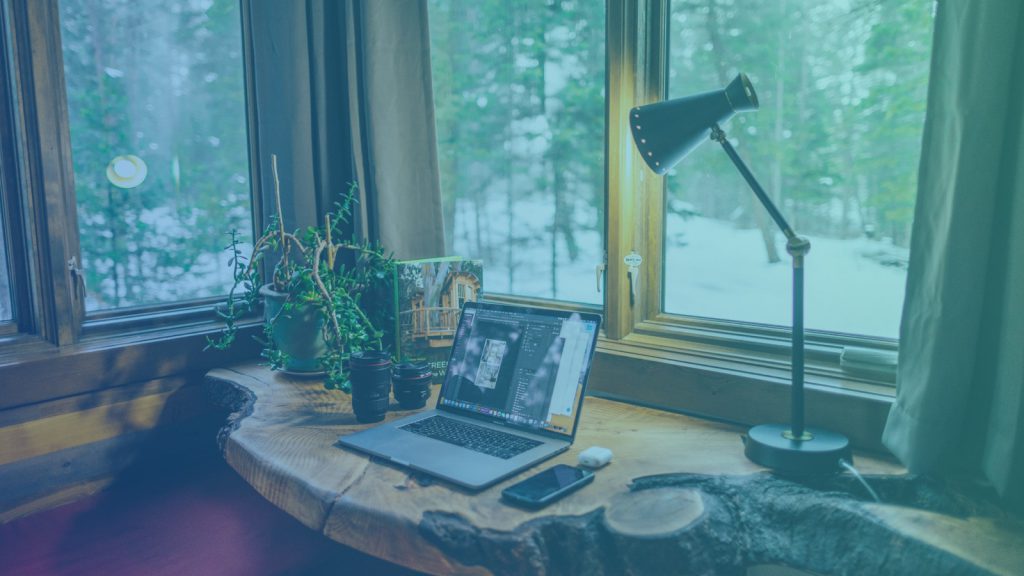At the time of writing this article, we are in a coronavirus lock-down in Europe. Many companies moved to remote work. We’ve therefore decided to create a common sense guide to a functional home office. While many will already have experience with the home office, we hope that everyone can find something small to make their experience even better.
Don’t just take this article as a response to the current crisis, though.
The guides here apply to any other home office situation: long-term sickness, freelancing, remote teams. Also, as there are many articles on this topic available already, we’ve specifically focused this article on the productive home office of marketers, CMOs, freelancers, agency workers, product managers, and other creative people used to work in teams and in offices primarily.
Step 1: Setting Up for Home Office
Let’s presume you currently have two environments:
- Your office, which is designed to help you focus, be productive, and stretch your brain as much as possible.
- Your home, designed for the absolute opposite. To relax, calm down, and refresh your mind.
You can’t, and should not attempt to magically turn your home into an office. But you do need to dedicate a space within your home to fulfill the office function. Ideally, a separate room. But if it’s just a single desk or an armchair, define and name it.
Spend some time, setting this place up. Create a comfortable environment to work, that limits distractions and promotes focus.
Areas you should focus on:
- allowing for good posture while working (raised screen, a mouse, a comfy chair, plenty of sunlight…)
- creating some form of barrier (i.e., closing doors – definitely not choosing to work from TV sofa ?) between the two spaces (home and office)
- promoting focus by getting all the required materials upfront (i.e., a pen, a notepad, replacing batteries in the mouse)
- limiting distractions by staying away from the devil’s trinity (TV, sofa, fridge)
If you don’t live alone, make sure that people around you know and respect your home office. Ask them not to be distracted when you are in your office, unless crucial. Set-up mutually acceptable rules.
Step 2: Daily Routine to Start a Successful Home Office
When you wake up, you shouldn’t start working instantly. Just as well, you shouldn’t procrastinate. Set a daily routine to get you kick-started.
- Get a good, healthy breakfast in the home environment (not in the office one).
- Do a morning exercise. Whether that’s HIIT with an app online (i.e., Seven), a yoga session, or just doing a bunch of squats. Get your heart pumping and fill your brain with oxygen.
- Dress for work. This doesn’t mean working from home in a suit. But also, don’t work in your pajamas. A good sense check is that you needn’t change for a videoconference.
- Open the windows, get fresh air into your home office and grab a coffee, tea, or other ‘healthy’ drink you’re used to having.
- Sit down, review your weekly plan, and make a daily list of what you want to accomplish. Use your calendar to create a realistic execution plan. Don’t expect to pull 8 hours of productive work. Strive for 5-6 maximum. This is especially true for creative work, like marketing, where quality trumps quantity.
Step 3: Working Through Your Day
Especially for marketers, we have to distinguish between hyper-focus and scatter focus work.
- When working on that brief, writing an article, or creating a detailed presentation, where our brains and creativity are crucial, we need to work in a “hyper-focus mode.”
- On the other hand, repetitive tasks such as filling out timesheets or attending meetings with others fall into the “scatter-focus mode.”.
Split your day so that you conduct hyper-focus tasks when you have the most energy and least distractions. Everyone’s different. Define for yourself if you work best before or afternoon. In any case, switch off all notifications (or all those you can). According to research, every small distraction (i.e., ping on your phone) can take up to 20 minutes to refocus. Try to stay in focus mode as long as possible. But don’t forget to take well-deserved breaks after every accomplishment to recharge! Use this time to go to the bathroom, get fresh air, or small-talk to your family.
On the opposite, plan your scatter-focus tasks for when you have the least energy and most distractions. Don’t, however, jump from task to task or fall into procrastination mode. Block procrastination-prone apps from your computer (i.e., social networks or news portals) using apps like Forest. Start a Pomodoro clock, and define, that you’ll work for 25 minutes and then take a 5-minute break. Use meetings to gather energy from others to help you accomplish tasks.
During the day, don’t forget to get a proper lunch break and get some sunlight (at least on your balcony⛱) to recharge. Just 10 minutes away from the computer can help you regain energy for most of the afternoon!
Step 4: Working With Others Remotely
So, as marketers, we are used to talking a lot and coming up with creative solutions in teams. How do we this, when we aren’t in one physical location?
- Maybe slightly counter-intuitive, but set up rules to promote individual hyper-focus mode. In an office, it’s easy to physically leave the discussion and enter your hyper-focus mode. When there’s no physical space to leave, and discussion moves to chats and calls, it gets a lot harder. So, as a team, agree on specific rules; no ad-hoc requests, no forced notifications when on DND, et cetera.
- Create a space for idea-sharing. Maybe a dedicated Slack channel, a digital mind-map, or an email string. Space, where people can jot down their ideas and others, can respond to them, in their own time.
- Do brainstorming online sessions. Ask everyone to come prepared to discuss a specific topic. Have everyone switch on their webcam (because 70% of communication happens non-verbally). Use a digital whiteboard (i.e., Miro) to discuss issues. But most of all, have a moderator that keeps the discussion on track. Remember that a meeting with 10 people, that’s taking 30 minutes more than it needs to, results in 5 hours of productive work time lost.
- Do quick daily stand-up meetings. 10 minutes max. Everyone shares what they’ve accomplished on that day. A great way to psychologically motivate each other and keep the team dynamic going.
- Have fun! Part of the office experience is sharing laughs, creating relationships with people, just generally enjoying ourselves. We all need our daily dose of coffee machine talk!!! ☕️ Just because you (or your entire team) is on HO, you shouldn’t turn into robots. Send each other jokes, start meetings with fun stories, do digital parties or daily meme challenges. The trick is keeping it all in balance.
Step 5: Balancing Work and Family
If you have kids, at this point, you’re probably saying, “Yeah, great, but none of this is possible with the two little dragons I’ve got at home.” You’re entirely right! There are some things you can try:
- if both you and your partner have a home office at the same time, switch (one works am, the other pm). 4 hours of meaningful work is much better then 8 hours meaningless. And you can always finish off when the kids go to sleep.
- if you don’t have a partner to switch with, try to provide your kids with meaningful entertainment. There are plenty of educational videos and courses that entertain kids of all ages (for example free Amazon Audible Stories for kids and teens)
- there’s nothing wrong with cheating a little. Accept that life will never be perfect. If you have to finish up a presentation for your boss, it’s okay to let your kids watch TV all day one day. It doesn’t make you a horrible parent.
Step 6: Closing It Off
You know, how at the end of every workday you commute home and have time to “depressurize”? Well, you have to do the same thing in the home office. Once you’re finished with all your tasks (or your brain switches off), run through an end-of-day routine:
- Write a list of your accomplishments that day (or clock the number of hours worked)
- Jot down on a paper, what you did great today and what you could do better?
- Create a plan of tasks for tomorrow.
- Finally, (and yes it is silly, but it works) stand up, switch your computer and light off and say, “I am done for the day. I’ve done the best I could and will carry on tomorrow.”
From that moment on, forget about work, recharge and relax.
To conclude, the home office is a skill just like any other. You can’t compare a day in the office with a home office day. Don’t be too hard on yourself. You won’t work 8 meaningful hours per day at home (just like you wouldn’t in the office). Don’t compare yourself to others. If you have an “off day,” remember you have those in the office as well. All you can do is strive to be better every day! And honestly, just by reading this article, you already belong to the top 10% of home office performers, because you care!
Further reading:



